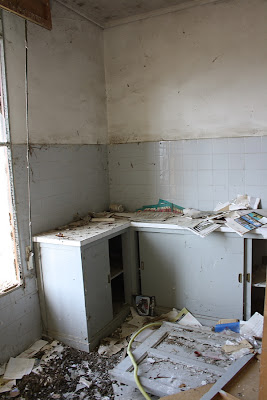It is always good to learn something, and it is time to know more about the Channel of Castille and its environment.
Walking along one of the branches of the channel we found this flour factory called "Las Luisas", an example of the many flour factories which thrived in Castile during the C20th, and are now mostly abandoned due to the business being less and less profitable, the rise on wheat prices or the lack of quality wheat suitable for the fabrication of bakery flour. This last factor is interesting, because not all kinds of wheat produce flour soft enough to be used in the bread we eat daily, and the best wheats tend to yield less tons per hectare than other varieties more suited to compound production. This, combined to the neccesity of farmers to produce more and more in order to reach the same earnings, has lead into sowing more productive wheat varieties (but with less quality) and the massive production of barley, tougher and easier to take care of.
The original factory was built in 1840. It was a mill next to the floodgate, and it consisted of a basement and two floors, until in the C20th a third floor and a set of electric engines were added. In the 70´s the factory got new owners, and in 1996 it was definitely abandoned, after more than 150 years of milling.

The factory has two blocks parallel to the channel, and three perpendicular to them, and the small buildings for the turbines, office, lab...
Next to the flour factory there is this small building which has been used as a stable and a refuge for hunters. There we found some shotgun shells.
The wheel which moved the water exiting the turbine.
In order to accumulate water and make it enter with enough pressure into the turbine, a pool was built. In the next pictures we can see the various lockgates and the filter (a metal grid) at the entrance of the turbine channel.
The main building had thee floors with a staircase on the outside. The walls were between 1 m and 80 cm thick, and have seven huge windows in each floor with curved lintels. The main and back facades are similar.
In the basement we can see the turbine axis. On top of it, in the mail building, there were the flour mills. Access is through the turbine drain channel, and it is quite dangerous since it is easy to fall off. That could be a quite bad experience, since there is a 3 m. fall and very little water....
At the office and lab entrance we found this pile of documents. Inside there is not much to mention about, apart from a small archive.
On the second floor of the warehouse there was a house. Now there are only some charred reamins after a fire that broke out after being abandoned.
The cuarta warehouse. Cuarta is a phase of the milling process, when the grain has been triturated several times but it has not still been compressed to get flour texture.
Next to the factory there were more warehouses of tercerilla (another milling phase) and cuarta. Now in the tercerilla warehouse there are two ruined silos. Access is strongly discouraged for evident reasons, including total collapse of the building with you inside.In the 90´s new silos were added at the sack warehouse. Before that, they produced their own sacks right there. Soon after building the silos the factory was closed and abandoned, and this is not an isolated example. Many other flour factories had the same fate and had to be abandoned after making a great investment in new equipment at the beginning of the 90´s.
I like the smell of asbestos in the morning...




































0 comentarios:
Post a Comment